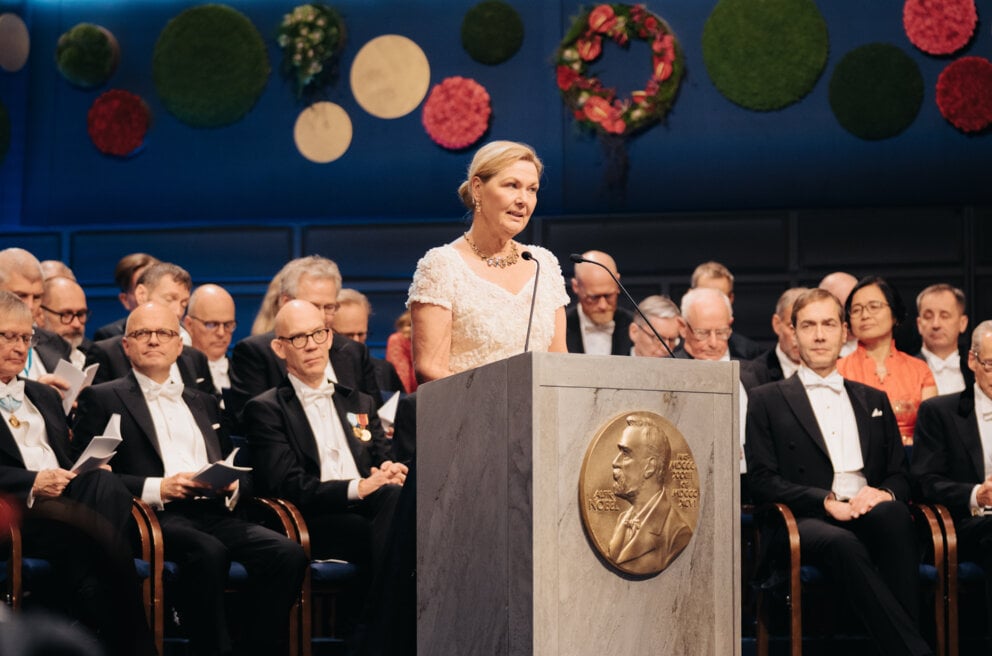Award ceremony speech

Professor Anna Wedell delivering the presentation speech for the 2022 Nobel Prize in Physiology or Medicine at Konserthuset Stockholm on 10 December 2022.
© Nobel Prize Outreach. Photo: Clément Morin
English
Swedish
Presentation Speech by Professor Anna Wedell, Member of the Nobel Assembly at Karolinska Institutet, Adjunct member of the Nobel Committee for Physiology or Medicine, 10 December 2022.
Your Majesties, Your Royal Highnesses, Esteemed Nobel Prize Laureates, Ladies and Gentlemen,
Who are we and where do we come from? These questions have long intrigued humanity. Everything living leaves traces through history. Ancient bones have long been studied, but detailed questions on how we are related cannot be answered in this way.
DNA provided new opportunities. DNA holds the code of life. Gradual changes to this code form the basis of evolution and remain in our DNA as traces from our ancestors. By comparing DNA, we can understand relationships between life forms and individuals. From an early age, Svante Pääbo was fascinated by ancient human history. During studies in immunology, he saw new possibilities and in secret, he studied Egyptian mummies with the latest DNA technologies.
His results drew attention around the world, but challenges were soon obvious. Ancient DNA cannot be easily captured even with the most advanced technology. Pääbo therefore embarked on a journey towards stringency and structure. Through deep knowledge on DNA biochemistry combined with technological brilliance, persistence, passion and collegiality, a new scientific discipline was born: Paleogenomics.
Finally, he was ready for his ultimate challenge, the genome of our closest extinct relative, the Neanderthal. By using new high-throughput sequencing technology and by coordinating an international consortium for data analysis, Pääbo achieved the seemingly impossible: analysis of the full Neanderthal genome sequence.
Homo sapiens developed in Africa, migrated out and lived side by side with Neanderthals who had adapted to the Eurasian continent for hundreds of thousands of years. Thanks to Pääbo’s discoveries, fundamental questions could be addressed and astonishing facts were revealed. Homo sapiens and Neanderthals had children together and we carry genes from our extinct relatives that affect us to this day, influencing for example how we react to infections. Pääbo also made the sensational discovery of a new hominin, by analysis of DNA from a tiny finger bone. The newly discovered Denisova also left genetic traces that live on and affect us today.
Svante Pääbo’s discoveries allow us to address one of the most fundamental questions of all: What makes us unique? Like us, Neanderthals had big brains, lived in groups and used tools, but these changed little during hundreds of thousands of years until the Neanderthals − for unclear reasons − disappeared. Homo sapiens on the other hand rapidly developed complex cultures, figurative art and advanced innovations. They crossed open waters and spread to all parts of our planet. Something happened that gave us new abilities.
Answers must lie in genetic changes that occurred after we separated not so long ago. Thanks to Pääbo’s seminal discoveries, genetic variants that are shared among all now living humans but absent in Neanderthals and Denisovans have been identified. Understanding their functional implications is an exciting challenge and a focus of Svante Pääbo’s current research.
I now want to honour the Nobel Prize laureates from 2020 and 2021. Harvey Alter, Michael Houghton and Charles Rice “for the discovery of Hepatitis C virus”. David Julius and Ardem Patapoutian “for their discoveries of receptors for temperature and touch”.
Dr Svante Pääbo,
your groundbreaking discoveries opened a window to our ancient past, with unexpected implications. The genomes of our closest extinct relatives provide a novel, much more recent, reference point for studies of who we are and where we came from. It takes more than genetics to understand what it is to be human. You have provided a solid biological foundation for further explorations of this fundamental question.
On behalf of the Nobel Assembly at Karolinska Institutet, it is my great privilege to convey to you our warmest congratulations. I now ask you to step forward to receive the Nobel Prize from the hands of His Majesty the King.
Copyright © The Nobel Foundation 2022
Nobel Prizes and laureates
Six prizes were awarded for achievements that have conferred the greatest benefit to humankind. The 12 laureates' work and discoveries range from proteins' structures and machine learning to fighting for a world free of nuclear weapons.
See them all presented here.
